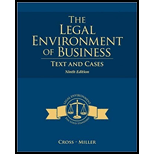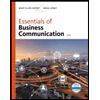
The Legal Environment of Business: Text and Cases
9th Edition
ISBN: 9781305764460
Author: Frank B Cross/ Roger LeRoy Miller
Publisher: CENGAGE C
expand_more
expand_more
format_list_bulleted
Question
Chapter 21, Problem 3BCP
Summary Introduction
Case s ummary : The workers of B, a factory warehouse, were required to follow the dress code which consisted of slack shirt and necktie for men and smock for the women. A female worker K and other female workers refused to wear the smock and they were fired for violating the dress code of the coat factory warehouse. The hours, salary, and benefits were similar for all male and female employees.
To find :Discrimination in dress code policy of B.
Expert Solution & Answer
Trending nowThis is a popular solution!
Learn your wayIncludes step-by-step video

schedule01:30
Students have asked these similar questions
Accounting answer wanted please help me to get solved
Not use ai and accounting
Can you explain the correct approach to solve this general accounting question?
Chapter 21 Solutions
The Legal Environment of Business: Text and Cases
Knowledge Booster
Similar questions
- Please given correct answer for General accounting question I need step by step explanationarrow_forwardThe following VAT balances were extracted from the subsidiary journals of Africa Traders as at 28 February 2024. R Cash receipts journal VAT input 556,50 VAT output 14 676,48 Cash payments journal VAT input 9 375,12 VAT output 642,78 Purchases journal VAT 6 260,40 Sales journal VAT 8 037,12 Purchases returns journal VAT 871,75 Sales returns journal VAT 902,32 On 1 February 2024, the VAT input account had a debit opening balance of R14 768 and the VAT output account had a credit opening balance of R14 154. Calculate the closing balance of the VAT output account as at 28 February 2024arrow_forwardRelever les défis de la gestion des ressources humaines, 6e édition (Chapitre 7, page 256) Auteur(s) Sylvie St-Onge, Victor Haines, Sylvie Guerrero, Julie Dextras-Gauthierarrow_forward
- Round your answer to the nearest whole percent? Financial accountingarrow_forwardHi expert please given correct answer with accountingarrow_forwardVista Motors has a total asset turnover of 2.9, a net profit margin of 6.25 percent, and an equity multiplier of 3.6. Calculate Vista's return on equity (ROE) using the DuPont equation. (Financial accounting)arrow_forward
arrow_back_ios
SEE MORE QUESTIONS
arrow_forward_ios
Recommended textbooks for you
 BUSN 11 Introduction to Business Student EditionBusinessISBN:9781337407137Author:KellyPublisher:Cengage Learning
BUSN 11 Introduction to Business Student EditionBusinessISBN:9781337407137Author:KellyPublisher:Cengage Learning Essentials of Business Communication (MindTap Cou...BusinessISBN:9781337386494Author:Mary Ellen Guffey, Dana LoewyPublisher:Cengage Learning
Essentials of Business Communication (MindTap Cou...BusinessISBN:9781337386494Author:Mary Ellen Guffey, Dana LoewyPublisher:Cengage Learning Accounting Information Systems (14th Edition)BusinessISBN:9780134474021Author:Marshall B. Romney, Paul J. SteinbartPublisher:PEARSON
Accounting Information Systems (14th Edition)BusinessISBN:9780134474021Author:Marshall B. Romney, Paul J. SteinbartPublisher:PEARSON
 International Business: Competing in the Global M...BusinessISBN:9781259929441Author:Charles W. L. Hill Dr, G. Tomas M. HultPublisher:McGraw-Hill Education
International Business: Competing in the Global M...BusinessISBN:9781259929441Author:Charles W. L. Hill Dr, G. Tomas M. HultPublisher:McGraw-Hill Education

BUSN 11 Introduction to Business Student Edition
Business
ISBN:9781337407137
Author:Kelly
Publisher:Cengage Learning

Essentials of Business Communication (MindTap Cou...
Business
ISBN:9781337386494
Author:Mary Ellen Guffey, Dana Loewy
Publisher:Cengage Learning

Accounting Information Systems (14th Edition)
Business
ISBN:9780134474021
Author:Marshall B. Romney, Paul J. Steinbart
Publisher:PEARSON


International Business: Competing in the Global M...
Business
ISBN:9781259929441
Author:Charles W. L. Hill Dr, G. Tomas M. Hult
Publisher:McGraw-Hill Education
